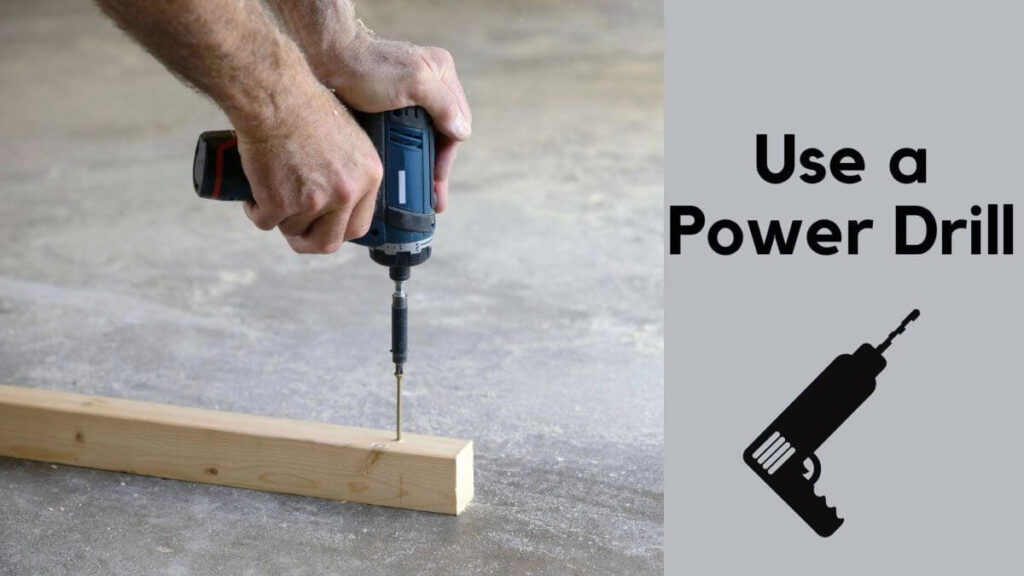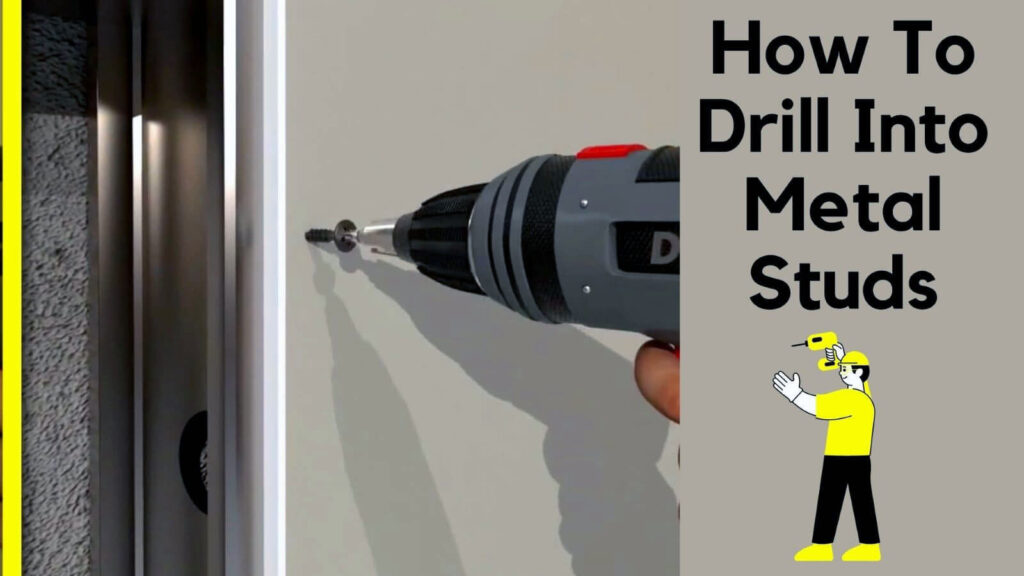Drilling into metal studs is different from drilling into wood studs. Metal studs are becoming increasingly popular in both residential and commercial construction due to their strength, durability, and resistance to warping or rot.
However, the process of drilling into them can seem intimidating, especially if you are unfamiliar with the right tools and techniques. This blog post will guide you step by step on how to drill into metal studs easily and safely, as well as provide valuable insights into the advantages and disadvantages of using metal studs in your projects.
Table of Contents
What are Metal Studs?
Metal studs are steel or aluminum structural elements used in framing walls, ceilings, and partitions in buildings. Unlike wood studs, metal studs are lighter, more durable, and fire-resistant, making them ideal for many modern construction projects. They are most commonly used in commercial buildings but are gaining traction in residential applications due to their sustainability and cost-effectiveness.
Metal studs come in a range of sizes, with the most common being 25 gauge (for non-load-bearing walls) and 20 gauge (for load-bearing walls). They have pre-punched holes to allow electrical wires or plumbing pipes to pass through, but when it comes to mounting heavy objects, drilling may be required.
What are Some of the Best Tools For Drilling into Metal Studs?
Drilling into metal requires specific tools to ensure smooth operation and avoid damage to the stud or drill bit. Here’s a list of the best tools to consider:
- Cordless Power Drill or Electric Drill: A cordless drill with variable speed control is ideal. Make sure your drill is powerful enough to handle the density of metal.
- Cobalt Drill Bits: Cobalt drill bits are designed for drilling through tough materials like metal. They are heat-resistant and offer a sharp cutting edge for smooth drilling.
- Screwdriver Bit: After making your hole, you’ll need a screwdriver bit to install screws or fasteners into the metal stud.
- Stud Finder: A reliable stud finder that can detect metal is essential for locating metal studs behind drywall.
- Safety Gear: Always wear safety goggles, gloves, and hearing protection to prevent injuries from metal shavings and loud noises.
Check Also: Homeowner’s Guide To The Best Drill For Concrete Walls!
What is the Best Way to Drill into a Metal Stud Step by Step?
Here’s a detailed, step-by-step process to safely drill into metal studs:
Step1: Choose the Location of the Studs in the Wall.
Start by using a stud finder to locate the metal studs behind the drywall. Unlike wood, metal studs have different density patterns, so ensure that your stud finder is set to detect metal.
Step2: Mark the Location of the Studs with a Pencil or a Piece of Paper.
Once you’ve located the stud, use a pencil or a piece of tape to mark the exact position where you plan to drill. It’s essential to drill directly into the center of the stud for a strong, secure hold.
Step 3: Use a Drill to Make a Hole in the Wall Just Above the Marked Studs
Attach a cobalt drill bit to your power drill and start at a low speed. Gently push the drill bit through the drywall and metal stud, making sure the bit doesn’t overheat. Use lubricant or cooling oil to prevent overheating and to make drilling easier.
Step4: Hang a String from the Top of the Drill Bit to the Bottom of the Hole.
This step is optional but can be useful if you’re mounting something vertically aligned, like shelving. By hanging a string, you ensure everything remains level and aligned.
Step5: Use a Power Drill.

Switch your drill to a medium speed for a smoother cut through the metal. Don’t rush; let the drill do the work. Once the hole is drilled, stop and clear away any metal shavings to ensure a clean surface for your screw.
Step6: Use a Jigsaw.

If the hole needs to be expanded, use a jigsaw with a metal blade to widen it. This is especially helpful if you’re drilling to insert piping or wiring through the stud.
Step7: Push the Stud Out of the Way and Hang the Light Fixture or Other Object from the String.
Once the hole is drilled and cleaned, insert the necessary hardware. If you’re hanging a fixture or shelf, ensure the anchors or screws are securely fastened into the metal stud for stability.
Check Also: How To Drill Marble Without Cracking
What are the Precautions You Should Take When Drilling into Metal Studs?
Safety Gear: Always wear protective goggles and gloves when drilling metal to avoid injury from metal shavings or debris.
Avoid Overheating the Drill Bit: Metal is a hard material that generates a lot of heat during drilling. Lubricating the drill bit with cutting oil or water is important to prevent overheating.
Don’t Apply Excessive Pressure: Metal studs are thinner than wood, so applying too much pressure can deform the stud or cause the drill bit to slip. Let the drill bit do the work at a moderate speed.
What are Some of the Common Mistakes People Make When Drilling into Metal Studs?
Using the Wrong Drill Bit: Not using a cobalt or high-speed steel drill bit can result in a dull bit, making the job difficult or causing damage to the stud.
Over-Drilling: Drilling too fast can heat up the bit and metal stud, causing the bit to become dull and less effective.
Not Marking Stud Locations: Drilling blindly without accurately locating the center of the stud can lead to holes in the wrong spots, resulting in weak mounting points.
Skipping Safety Measures: Ignoring safety gear like gloves or goggles can result in injuries from sharp metal shavings.
How Can You Prevent These Mistakes?
Always Use Cobalt or Tungsten Drill Bits for their durability and efficiency when cutting through metal.
Mark Stud Locations Clearly with a pencil or tape, ensuring you are drilling in the right place.Drill at a Slow Speed to reduce heat and avoid damaging the stud or drill bit.
Always Wear Protective Gear and work in a well-lit area to avoid accidents.
Read More: Drill into Plexiglass Without Cracking
What is the Advantage of Using Metal Studs?
Durability: Metal studs are more resistant to warping, moisture, and fire compared to wood.
Cost-Effective: In many cases, metal studs are cheaper than wood, especially in commercial projects.
Lightweight: Metal studs are lighter and easier to handle, making them more convenient for large-scale construction.
What is the Disadvantage of Using Metal Studs?
- Requires Special Tools: Drilling into metal studs requires specific tools, such as cobalt bits and metal-cutting saws, which may not be readily available to all DIY enthusiasts.
- Weaker Anchors: Metal studs are thinner than wood, which can result in weaker connections for screws and nails, especially if not drilled properly.
FAQs About How To Drill Into Metal Studs
Is it possible to use my Phone as a stud finder?
Yes, there are apps available that can turn your phone into a basic stud finder by using the phone’s magnetic sensor. However, these apps are not as reliable as dedicated stud finders.
Is it possible to drill through metal with a cordless drill?
Yes, you can drill through metal studs with a cordless drill, but ensure it has enough power and use the correct drill bit, such as a cobalt or tungsten carbide bit.
How deep should a screw be inserted into a stud?
The screw should be inserted at least 1 to 1.5 inches into the stud to ensure a strong, secure connection, especially when hanging heavy objects.
Final Opinion
Drilling into metal studs can be straightforward if you follow the right steps, use the proper tools, and take necessary safety precautions. With metal studs becoming more popular in construction, knowing how to drill into them safely and efficiently is a valuable skill for any DIYer or professional builder. Whether you’re mounting shelves, installing a light fixture, or hanging pictures, drilling into metal studs with precision will ensure a secure and lasting installation.

Hey, I am MD Hrithik Hossain, I’m a huge fan of DIY crafts. My workshop is where I spend most of my spare time, and I’m always working on some project. To that end, I’d like to share some of my knowledge and experience with you in power tools, woodworking, and other specialized materials fabrication.
I will guide you with genuine knowledge that can assist you with deciding whether a drill is appropriate according to your requirements or not. If you want to find the best drill and know which type of drill is most suited for your needs, then I can guide you with my expertise. My passion lies in helping others find the correct products they need at an affordable price.


